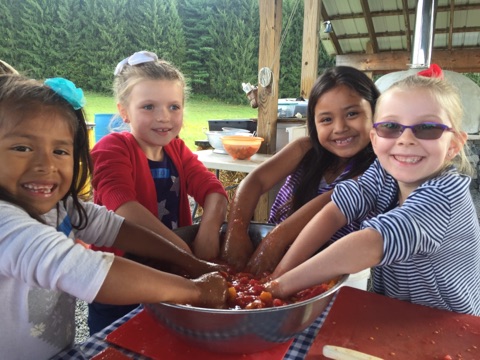
It’s happening. We feel it. Mornings have a distinct chill that crawls up our fingers as we gather animal feed and handle other various chores with the sheep and chickens. We have our sweaters on and our sheep are starting to thicken up their wool. But even though the first autumn leaves are falling, the garden seems to be taking one last stand against the cold winter with a boost of fall momentum. Our cherry tomatoes are still balls of sunshine and heirloom varieties continue to ripen and turn into reds, oranges, and yellows.
There’s often a lot of confusion about what qualifies as an heirloom tomato or a hybrid, and how to tell the difference. A hybrid vegetable is created when two different varieties of plants are intentionally crossed to produce an offspring that has the best qualities of each of the parent plants. Farmers or plant breeders produce hybrids to improve flavor, disease resistance, yield, or a myriad of other reasons. Cross pollination is a natural process that gives us some of our favorite tomatoes, like Sun Gold cherry tomatoes, which taste more like sunshine in a circle, than nightshades.
Heirlooms, on the other hand, are typically at least fifty years old (the variety, not the fruit) and have been hand selected by gardeners for their special traits. All heirloom vegetables are open-pollinated by wind or insects without any intervention. Heirloom variety tomatoes are often kooky, quirky, and have unbeatable flavor. A favorite of The Sylvia Center is the Ox Heart tomato, which makes a sensational tomato grilled cheese sandwich.
When kids visit Katchkie Farm, they get to see and taste many, many varieties of tomatoes. This season, we’ve grown over twenty varieties in our children’s Learning Garden alone, including the Violet Jasper, Sungold, Green Zebra, and Brandywine varieties. And in the past month, the combined powers of visitors and staff have likely eaten the equivalent of several small elephants in tomatoes.
In late August, campers made fresh pasta with Chef Luca that showcased heirlooms and hybrids alike at our annual farm camp. Oftentimes, kids (and adults too!) will insist that they despise all cherry tomatoes before exploring the tomato jungles in Farmer Bob’s greenhouse and secretly popping a dozen or so in their mouth before touring the farm only to see waves of red, orange, and purple down the rows of Katchkie Farm.
The first group of students to come after the start of the school year harvested many herbs, including chives and oregano, and prepared hearty butternut squash minestrone and coconut, raisin granola that perfumed the air so richly. Soon enough, we’ll be enlisting the help of students to tuck beds in for the winter, lining them with compost and straw to promote overall plant health, prevent winter damage, and ensure that all the soil can make it to March, when we’ll begin again. But for now, we look forward to fall brassicas, digging potatoes, and showcasing warm veggie-filled soups.


